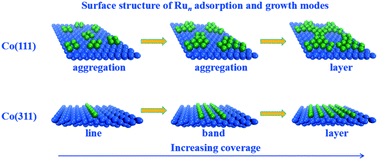Insight into the structure and morphology of Run clusters on Co(111) and Co(311) surfaces†
Abstract
The adsorption configurations, growth modes and morphology of a Ru promoter under the approximate conditions of cobalt catalyzed Fischer–Tropsch synthesis (FTS) were investigated by density functional theory (DFT) calculations. On both Co(111) and Co(311) surfaces, the Run aggregation growth mode is energetically more favored than the dispersion mode, and two-dimensional adsorption configurations are more stable than three-dimensional isomers that possess more edge and vertex atoms with higher surface energies. On both surfaces, the diffusion barriers for Ru atoms are very small, which allows them to occupy the most favorable adsorption site readily and thus facilitates the Run aggregation. Ab initio molecular dynamics (AIMD) simulations reveal that three-dimensional adsorption structures will collapse to planar monolayer structures under FTS reaction conditions, consistent with thermodynamic studies showing that the planar structure is lower in energy. Electronic structure analyses suggested that accompanied by electron transfer from surfaces to clusters, the interaction of Run clusters with Co surfaces derives from the hybrid d orbitals between the Co and Ru.



 Please wait while we load your content...
Please wait while we load your content...